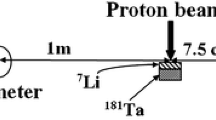Abstract
Presently accelerator facilities emphasizes on generating charged particles with enhanced energy and flux. The radiation protection practices at these facilities are considered in civil engineering designs and strictly implemented through different administrative, access control measures (Sarkar in Radiat Meas 45:1476–1483, 2010). However, concern arises from induced activities, during maintenance and decommissioning stages, when sections of accelerator and shielding materials become highly radioactive. Major contribution of induced activity arises from stainless steel (SS-304) beam enclosures and Cu-dumps. Present work focuses on the generation of induced radioactivity profiles with delay counting of SS-304 and Cu along with instantaneous gamma and neutron dose rate measurements at various proton energies for source term estimation.








Similar content being viewed by others
References
Sarkar PK (2010) Neutron dosimetry in the particle accelerator environment. Radiat Meas 45:1476–1483
Blaha J, La Torre FP, Silari M, Vollaire J (2014) Long-term residual radioactivity in an intermediate-energy proton linac. Nucl Instrum Methods Phys Res Sect A 753:61–71
Fasso A, Silari M, Ulrici L (1999) Predicting induced radioactivity at high energy accelerators. SLAC-PUB-8215, pp 1–9
Bungau C, Bungau A, Robert C, Roger B, Thomas RE (2014) Induced activation in accelerator components. Phys Rev Sp Top. Accel Beams 17:084701:1–084701:12
Masumoto K, Takahashi K, Nakamura H, Toyoda A, Iijima K, Kosako K, Oishi K, Nobuhara F (2013) Measurement of induced radioactivity in air and water for medical accelerators. TIF-11, NEA No. 7157, vol 1, p 8
Torre FL (2014) Study of induced radioactivity in proton accelerator facilities. Universität Bern, Ph.D. thesis (http://inspirehep.net/record/1296409/files/652560017_CERN-THESIS-2014-009.pdf)
Gurjar OP, Jha VK, Sharma SD (2014) Radiation dose to radiotherapy technologists due to induced activity in high energy medical electron linear accelerators. Radiat Prot Environ 37:25–29
Toshioh F, Satoshi O, Ichiro Y, Masaya O, Hiroshi W, Takeji S, Kazuaki K (2012) Induced radioactive nuclides of 10-mev radiotherapy accelerators detected by using a portable HP-Ge survey meter. Radiat Prot Dosimetry 148(2):168–173
Ranft J (1972) Estimation of radiation problems around high energy accelerators using calculations of the hadronic cascade in matter. Part Accel 3:129–161
Singh P, Rao SVLS, Pande R, Basak T, Roy S, Aslam M, Jain P, Srivastava SCL, Kumar Rajesh, Nema PK, Kailas S, Sahni VC (2007) Accelerator development in India for ADS programme. Pramana J Phys 68:331–342
Paul S, Sahoo GS, Tripathy SP, Sharma SC, Ramjilal S, Ninawe NG, Sunil C, Gupta AK, Bandyopadhyay T (2014) Measurement of neutron spectra generated from bombardment of 4 to 24 MeV protons on a thick 9Be target and estimation of neutron yields. Rev Sci Instrum. 85:063501-1–063501-8
NNDC BNL table of isotopes: NUDAT 2.7: https://www.nndc.bnl.gov/nudat2/. Accessed 23 Oct 2019
Suman V, Tripathy SP, Sunil C, Shanbhag AA, Paul S, Sahoo GS, Bandyopadhyay T, Sarkar PK (2016) Measurement of neutron energy distributions from p + Be reaction at 20 MeV using threshold activation foils. IEEE Trans Nucl Sci 63:2283–2292
Acknowledgements
The authors would like to thank the Pelletron facility staff members for their support during the experiment. Authors sincerely thank Dr. R. M. Triapthi, former Head, HPD and Dr. K. S. Pradeepkumar, former Director, Health Safety & Environment Group, BARC for providing their support and inspiration during the entire course of work.
Author information
Authors and Affiliations
Corresponding author
Additional information
Publisher's Note
Springer Nature remains neutral with regard to jurisdictional claims in published maps and institutional affiliations.
Rights and permissions
About this article
Cite this article
Paul, S., Joshi, D.S., Shanbhag, A.A. et al. Induced activity from Cu and SS-304 targets on proton bombardment. J Radioanal Nucl Chem 323, 1299–1306 (2020). https://doi.org/10.1007/s10967-019-06918-7
Received:
Published:
Issue Date:
DOI: https://doi.org/10.1007/s10967-019-06918-7




